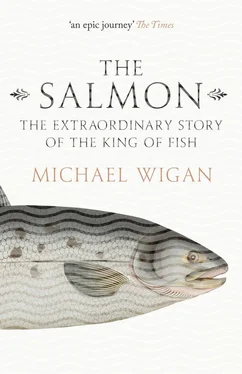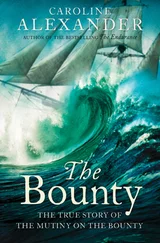Tagging has shown that salmon often enter a river, stay a while, and then leave it. During a long summer salmon may climb rivers, fall back to brackish estuaries, wait for another oxygen-rich freshet to stimulate a move upstream again, and then repeat the yo-yo procedure. Although Atlantic salmon are renowned for their generally faithful return not only to the river of origin but to the section of river from where they broke out of the egg, they can mess with the rules too.
A salmon has been tracked tasting the water on Scotland’s west coast for a while, then moving to an east-coast river, and finally ascending the third river it had trialled in one year, where it spawned. This ranks as an extreme example of genetic straying. A salmon tagged on the Dee in Wales was re-captured in Denmark. I am unsure whether a salmon tagged in Europe has ever spawned in North America; reports vary, but betting against salmon’s versatility and survivor-adherence would be a mistake.
I was on Russia’s Kola Peninsular on a river called the Kharlovka in low-water/high-temperature conditions when it appeared to the anglers and the ghillies that the fish actually left the river, retreating to the refreshment and oxygen of the open sea. We could see them driving downriver. At this point the sea was only a mile or two distant. There would be a good enough reason: when wild salmon are closely confined fungal diseases spread fast. They can spread even faster amongst fish in low water and even disfigure a whole river population. Saltwater does the laundry.
Salmon fungus comes in more than one type, and can keep growing on fish that are already dead. The fungus is an external manifestation of a fast-spreading microbe. It is normal even in ordinary seasons to find pre-spawning salmon with white fungus starting on their heads and backs, and when spawning is done these mouldy discolorations accelerate to be abrupted only when the fish is cleansed by saltwater. Warm, low-water river conditions make matters worse.
Managers report that this occurred on the Tweed in Scotland late in 2011. It was not the potentially lethal condition called ulcerative dermal necrosis (UDN), in which lesions can penetrate into skeletal tissue, rather, as assessed by the river biologists, a more common fungal affliction broadly termed Saprolengia , caused by overcrowding.
The last time fungal diseases killed huge numbers of pre-spawners in Scotland was in the 1960s, when runs were prodigious. I remember walking down to look at the water in August with my grandmother, a dedicated angler who went to the river as others go to their office. White lethargic salmon with rot peeling from them cruised aimlessly in shallow water. I recall her sombre mood. Some see fungal outbreaks on a major scale as a response to over-population, and this distressing scene did indeed coincide with a heavy run of fish. Widespread fungal attack has not recurred on this river since.
Fishermen are the best monitors of a river-system. Their observations and speculations about this fish serve the species well. What salmon do in rivers will probably preoccupy anglers for as long as they persist in trying to catch the fish in what might be seen as an elaborate manner. Easiest perhaps then, sifting the options for evidence, to watch salmon in rivers.
I remember meeting a German salmon angler in Ireland long ago who had adopted a rigidly logical Teutonic approach to his fishing. Having showed me a rack of twenty-foot rigid poles, he asked what I thought he did when he went fishing. As if it was the most obvious thing in the world, he cried, ‘I climb a tree!’ When sun shone on the pool he was to be located hanging out of his tree wearing polaroids. From above, the river was like glass. For this Germanic genius it was self-evident that to cast into a river in the hope of catching a fish you did not know was there amounted to a bizarre and undignified expenditure of energy. So he looked down from aloft and spied, from his vantage points along the River Blackwater, whether any salmon were available for the catching.
He then drifted flies, of his own special construction, of course, over the noses of the targeted fish until they lost patience and snapped. Invariably, he assured me, they all eventually break, irritated to a frenzy, like a person with a spider crawling on his face. The idiosyncratic sportsman claimed to have caught numerous fish in this manner. He said snapping-time was always inside three-quarters of an hour.
Thinking on it, catching them on those rigid poles must have made it a mechanical exercise, lacking in the intimacy of galvanic contact. But there was the hunter satisfaction, I suppose, of having behaved in an impeccably rational manner.
I recall a scene one summer on the Saint-Jean River in Quebec where the water is pellucidly clear. I was walking down the river-bank when I came across an angler lying atop a small bush with his hat tilted over his eyes. Striking up a conversation it transpired he was waiting for ‘his’ fish and the right moment. I pressed him more and he showed me the fish, which I took a while to detect. Stretching far out in front was a rippled pavement of smooth, light-coloured rock. The water looked shallow, maybe three feet deep. Eventually I spotted, nestled into what was no more than a groove, a very large salmon, its back beautifully camouflaged in the ochre tones of the undulating river floor. The angler said he had tried his fish earlier in the day with the sun just rising. The fish had moved and moved again often but never opened its mouth. The next suitable moment would be as the sun disappeared over the canyon side. The angler had six hours to go. He seemed unruffled at the prospect, and sure the fish would succumb. He intended drifting his fly down from some distance above to give the big fish time to see it, and then letting it slide over his nose closer and closer, till … the chapter was written in his mind before it had even taken place.
The interesting time for salmon-watching is late summer when numbers are building for the orgy of spawning. Upstream of the river-bridge to my home is the entrance to a tributary. Salmon gather below the bridge for the shade, perhaps, but also to wait for the right moment to run the tributary and spawn there. The place where they accumulate looks the same as the rest of the river-bed, a trifle deeper maybe, stones studding the sandy bottom. They have stations, places they like to be. These are not, as is often loosely said, ‘behind’ rocks, rather to the side or below. There they rest, pointing upstream, close to the bottom, occasional bubbles emerging lazily from their mouths, like giveaway wisps of smoke from rainforest tribes.
In the protection of this shady place at a certain point in the autumn the salmon numbers stack up in a diamond formation. To start with, a few just take positions here and there, but as spawning approaches they tighten into a formation. As the days pass and no rain raises water levels, the space they are occupying shrinks and gets cramped with more fish still arriving. It is like a rail terminus with no trains leaving. The water lacks the refreshment of oxygen. I have seen the mass of salmon get edgy and impatient; they start to jostle and swirl at each other. There is a palpable build-up of nervous tension.
One time this was dramatised in a remarkable way. Above the bridge swam a pair of mergansers, paddling on the side of the river. Like a torpedo in an old war movie, a large fish suddenly charged the two sawbills. He launched himself from at least 60 feet and, missile-like, broke the surface enough to create a bow-wave. The mergansers, sensing something at the last moment, rose in a panic of clattering wings and flew fast away.
Well, salmon do not in theory attack birds, but the fact is that mergansers are major predators of salmon eggs, a difficult enemy for the progenitors because the sawbills get their necks and beaks under the water and then shovel through the redds removing the buried caviar. Salmon hide the eggs in their redds and assume they are safe until the little alevins wiggle out in warming springtime sunshine; they cannot remain on duty to stand guard. I have seen a merganser in Canada surfacing from redd-raiding with salmon eggs cascading down its chest. I believe that cock salmon recognised in the merganser pair, with their elongated predator shape and thin heads, a predator enemy. It was a bird-fish interaction I will never see twice.
Читать дальше












